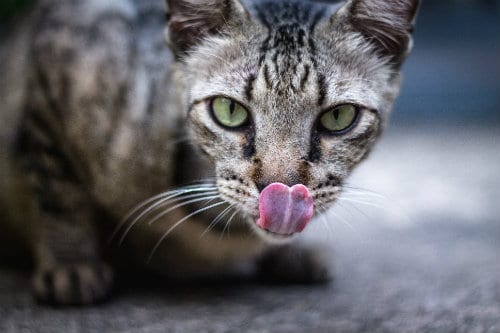Coconut oil is a health food craze at the moment, and for good reason. There are tons of goodies inside this white oil; solid when cold and liquid when warm. It’s great for cooking, it’s wonderful for the skin, and it’s even healthy for cats.
In this article, we’re going to explore how it is that coconut oil can help your furry friend to have a shiny, healthy coat. Holistic veterinarians are fans of coconut oil, and we’re going to explore how to properly apply it for the best overall benefit.
Benefits of Coconut Oil for Cats

There are a ton of key benefits to using coconut oil for your cat. When used externally, coconut oil can help with dry skin, allergies, and coat health. When consumed, coconut oil is great for the cat’s immune system, reduces the inflammation associated with arthritis, and even helps with hair balls.
Not only does it reduce inflammation naturally, but coconut oil also helps with bad cat breath, helps to heal the stomach, and can be an internal way to deal with the exterior problem of dermatitis. In truth, all the health benefits that you read about in terms of how coconut oil helps humans, the same goes for your cat.
How to Use Coconut Oil
So, now that you know the key benefits, it’s time to explore how to use it. In small amounts, it can be administered as food, and it can also be used topically for skin problems. Keep in mind that when using it as a food supplement, you shouldn’t use too much too soon.
You need to introduce coconut oil slowly so that it’s better tolerated and doesn’t cause an allergic reaction. Also, when added too quickly to the diet it can cause diarrhea, and we know for sure that you don’t want that. When it comes to an average size cat, start with 1/4 to 1/2 teaspoon once a day.
When building your coconut regimen, only use an extra 1/8 teaspoon daily. If you’re using coconut oil to prevent hairballs, then it only needs to be administered once or twice a week. In general, observe your cat and adjust the amount as needed.
Do you think it’s going to be a tough job getting your cat to eat that oil? Well, think again because coconut oil just happens to be popular amongst cats. They like the flavor and texture, and if they don’t accept it right off the spoon, then simply add it to their food.
Risks of Coconut Oil for Cats
As with anything, there are some risks, and the same goes for coconut oil. The ASPCA has already stated that coconut oil cannot do much harm to your cat, but every cat is different. Some will experience an upset stomach or diarrhea. In this case, you either gave too large of a dose or your cat is intolerant.
Keep in mind that coconut oil is a food that is high in saturated fat, and this can lead to pancreatic inflammation in some cats who are sensitive. If your cat has trouble with their pancreas, then they should be monitored closely when using coconut oil.
Also, keep in mind that coconut oil is very high in calories. If your cat has trouble with weight gain, then using the oil might not be the best idea. There are some supplements on the market that provide the fatty acids in coconut, without the fat itself.
Alternatives to Coconut Oil
It may disappoint you if your cat does not tolerate coconut oil, but there are alternatives that you can use. Fish oil is a good place to start, and it has quantities of healthy Omega 3s which coconut oil does not. When ingested, fish oil has a number of benefits, and olive oil can be used on the skin in much the same way that coconut oil is used.
When choosing fish oil, select salmon, anchovy, and krill. Be sure to not use these topically as you don’t want your cat to smell fishy! Olive oil has a delicious smell, and so you won’t mind that when using it to heal your cat’s skin.
The Superfood of Our Age

Coconut oil is being called a superfood these days, and when your cat tolerates it, they can reap the benefits. Food-grade coconut oil can clear up a number of different symptoms, and it’s a natural remedy that can soothe many ailments. Let’s take a look at some more ways in which your cat can benefit from coconut oil.
Coconut Oil as a Cat Skin Moisturizer
Just like yours, a cat’s skin gets dry. You may have found in the past that applying coconut oil to dry patches makes a world of difference, and your cat can experience that soothing relief as well. When it comes to dry, flaky skin, simply use a bit of coconut oil to relieve the itch and burn.
How to Apply Coconut Oil
Both ingesting and applying topically will improve the moisture level of your cat’s skin and coat. Begin by taking the coconut oil and rubbing it in your hands to soften, then apply all over the skin. To make sure that your cat does not lick off the oil after application, use a standard Elizabethan collar.
Coconut Oil for Cat Gingivitis
Cats get gingivitis, just as we do, and coconut oil is a great remedy. Gingivitis is inflammation of the gums, and it’s very uncomfortable. This can occur when you don’t regularly brush your cat’s teeth. When using coconut oil for gingivitis, rub a pinch of the oil directly onto the gums to treat the inflammation.
Coconut Oil to Slow Kidney Disease and Cancer
Although coconut oil isn’t as rich in Omega-3 as fish oil is, it still does have some. This can assist in slowing kidney dysfunction, and it can even slow the progression of cancer in your cat. Not only does it do all this, coconut oil also has aminos that provide extra protein and energy for your cat.
Relieve Cat Constipation

Hey, it happens to everybody. There’s no reason why your cat has to suffer from constipation, and coconut oil is a great remedy. It absorbs easily in the digestive tract, and it’s a safe way to move things along when they come to a halt. That’s because the fatty acids push stool that is backed up in the intestinal tract.
When using coconut oil for constipation, give your cat a half teaspoon for every 10 lbs of body weight, once per day. They’ll usually just lick it right off the spoon, but as stated earlier, you can also mix it into their food. If your cat is still constipated, then go ahead and increase the dosage.
Use Coconut Oil to Improve Brain Power
When cats get old, their brains slow down and they don’t react as quickly as they once did. Coconut oil can improve brain energy metabolism thanks to medium-chain triglycerides. This is particularly beneficial in senior pets.
When seeking to improve brain function, feed your cat one-quarter teaspoon per 10 lbs of body weight twice per day. Again, either feed it on a spoon or mix it in with their food.
Coconut Oil for Lean Body Mass

There’s a paradox when it comes to coconut oil, and that is, even though it’s full of saturated fat, it promotes lean body mass in some. The National Institute of Health found that, when testing 50 overweight cats, coconut oil helped with weight loss and creating leaner body mass. That means that the oil improves metabolic function.
When using coconut oil to promote lean body mass, mix one-half teaspoon with their food once a day. If you notice that this is only making your cat fatter, then stop the use of the coconut oil immediately.
Let’s Talk About Safety
We already mentioned that coconut oil is quite safe, but let’s get down to the nitty gritty. Coconut oil is comprised of only fat; that’s 14 grams of fat, 13 grams of saturated fat, and 117 calories per tablespoon. Because it’s so fatty, it’s recommended that you add it gradually. Here are some things to look out for:
- Excessive vomiting, diarrhea, or other digestive issues.
- In some cats, hydrogenated oils cause fatty liver. If your cat suffers from liver problems, be sure to favor virgin coconut oil.
- Don’t force things. If your cat is not liking the taste of coconut oil, then don’t make them do it. Forcing oil into a cat’s mouth is actually quite dangerous.
- Talk to your vet before adding coconut oil to your cat’s diet.
The Bottomline
Organic, pure coconut oil is not only safe for cats, it offers a number of health benefits without needing to use medication. Not only is it readily available, you can also find inexpensive bottles on the market, and they’ll last you for a long time.
When used daily, coconut oil can provide results that your cat can see and feel, and while you’re at it, might as well have a teaspoon yourself! Coconut oil is a superfood that benefits both humans and animals, so the next time you’re at the store, be sure to pick some up. But do make sure that it’s the pure kind. Quality makes all the difference in the world.
"In ancient times cats were worshipped as gods; they have not forgotten this."
-- Terry Pratchett






Thanks. I thoroughly enjoyed reading your entire article. It is very informative and factual. One thing….could you perhaps teach us the very few but safest ways to restrain a cat when cleaning their ears of mites? Hmmm…please?
Lisa